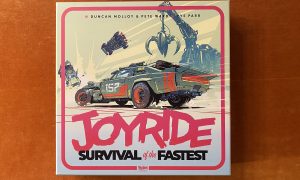So much for global warming! The earth has suffered cataclysmic climate change plunging it into a new ice age. You are leading a tribe of survivors and your goal is to have the largest tribe at the end of the game. Arctic Scavengers, while actually an older game, attempts to bring some new twist to deck-building, but unfortunately, the twists don’t add together to a great game.
Components (Rio Grande Edition)
Base Game
- 144 cards:
- 14 Contested Resources cards
- 69 Mercenary cards
- 20 scavengers
- 10 brawlers
- 8 hunters
- 8 saboteurs
- 8 scouts
- 5 group leaders
- 5 sniper teams
- 5 thugs
- 36 Tool cards
- 20 “Refugee” cards
- 6 “Junk” cards
- 1 setup / initiator card
- 1 junkyard cardboard mat
- 1 contested resources cardboard mat
- 1 rules reference cardboard mat
HQ Expansion
- 41 cards
- 10 tribal leaders
- 12 buildings
- 8 toolkits & rifles
- 16 new mercenary cards
- 8 medics
- 8 engineers
- 3 gangs
- 1 build cardboard mat
- 1 building cover cardboard mat
The rule book does have some typos that are frustrating but not game breaking. For example, the listed number of contested resource cards is wrong. The rules also lack clarity when to for when to shuffle the junkyard deck.
Another major annoyance is that you cannot close the box all the way after you open the game. Once the cards have been placed in their labeled slots in the box, the small boards used to indicate the different piles do not fit and the box rests half an inch too high. The designer posted on BoardGameGeek a way to cut the insert so that it would work, but Rio Grande should not have made such a hack necessary.
The artwork helps convey the theme well. The components are of a good quality too, with thick cards and thick cardboard mats for marking the different decks.

Rules Overview
The game is won by having the most tribe members at the end. The number of tribe members is not the number of cards in your deck, instead it’s the sum of each card’s worth as indicated on it. So, they’re abstract victory points. Unlike Dominion, there are very few cards that are just victory points. Useful cards are worth a small amount of tribe members, while cards that aren’t helpful have a lot.
Each turn has two phases. First, players in turn order play cards from their hand to collect resources. All actions a card might be used for are listed along the left edge of the card,with blanks indicating that a card cannot be used for that action. When you choose to do an action you usually play multiple cards, add up their strength for that action, and then perform it. Drawing allows you to draw cards equal to the sum of the draw symbols. Digging allows you to look at a number of cards from the junkyard deck equal to your digging symbols and keep one. The junkyard deck is a pile of shuffled facedown cards which include tools, medicine, and “junk” cards. Hunting allows you to gain food to buy a new tribe member with. Food only last the round that you generate it, so it is very much like money in other deck building games.
The second part of a player’s turn is committing cards to skirmishing. Skirmishing is one of the values that a card can have and it is used to win the contested resource card that round. After a player collects resources he places his remaining cards face down as a bid to win the facedown “contested resource” card. Some of the contested resources cards are very good and some are only so-so. Once everyone has completed their resource collection and placed some cards facedown, then all players simultaneously reveal their cards and compare skirmishing strength to determine who wins. The winner of the skirmish places the contested resource card in his discard pile. Once the contested resources deck is emptied the game is over, and players count up the number of tribe members listed on the cards in their deck.
Tools are an important part of the game and are acquired from the junkyard and the contested resources pile. Tools give a boost to one or more actions but must be played with a tribe member who can do that action. Medicine is also very important and easy to miss your first game. It can only be acquired in the junkyard through digging but is necessary for recruiting the best tribe members.
The Rio Grande version of the game ships with a small expansion in the box. The expansion provides some neat additions. There are goal cards that give points for having the most buildings, medicine, or tools. Each player starts with a leader who provides a specific ongoing bonus. Many of these revitalize the mostly dead cards in your starting hand. The third thing it adds are buildings, which allow you to store cards from turn to turn. There are also some additional cards to buy, including one that gives medicine, a much needed addition. After your first game I recommend playing with everything in the expansion.

Why You Might Like Arctic Scavengers
The contested resources stack is a neat twist on deck-building. Instead of buying victory points or the best cards, as in many other deck-building games, you have to win them by playing higher cards than the other players. This value that you win with, skirmishing, does not help you buy cards the normal way. Buying cards is done with a different resource, food. Fighting for the contested resource also allows for some bluffing. If you draw a bad hand you can put more cards down, bluffing that you have a lot of skirmishing and will win the contested resource. Bluffing is unusual in a deck-builder and keeps the game fun.
The junkyard is unique and changes things up from the typical deck-builder. This is another element where you can’t buy your way to victory. You have to get lucky and draw what you need. The more digging skill the better the chance of drawing a good card to keep.
The game is not multi-player solitaire. In many deck-builders you can plan your turn out completely once you draw your hand. Others require a little bit of modification due to other player’s draft choices, but this is more of a denial mechanic. Arctic Scavengers has the direct competition of the skirmishing as well as a few cards that let you target and neutralize other player’s cards. This is a much more interactive game than most deck-builders.
Why You Might Not Like Arctic Scavengers
The greatest reason you might not like Arctic Scavengers is that it is highly random. A game with strategic and satisfying decisions has allows good decisions to be rewarded and has just enough luck to provide variety and eliminate single dominant strategies. In most deck-builders this randomness comes from the cards drawn from the deck. Arctic Scavengers has two more major sources of randomness. The contested resources pile is random, meaning that the reward for your decisions is random. The junkyard pile is random too, so the result of your digging decision is random as well. This ends up being too much randomness for me to feel satisfied that the best player won.
Playing with a set of ten out of the possible twenty-five cards gave Dominion, the first and best known deck-building game, a lot of variety.In Arctic Scavengers you always play with the same set of eight cards. Variety does not come from the choices you make, like which cards to draft this game, but instead the randomness of the contested resources, junkyard, and other player’s skirmishing actions.
The game takes exactly sixteen turns, which makes it feel like it ends too soon.I never got my deck running smoothly before the game ended, so the game never felt satisfying. The fun of a deck-building game is to get your deck working, draw the synergies you planned for, and earn victory points from your well-tuned deck. In this game I felt like my deck building decisions were not paying off before the game ended.
Who Can You Play With and How Hard Is It to Learn?
This game works well with a typical mid-weight board gaming crowd. People who have played Dominion or other deck-builders will have the easiest time learning, but anyone who has played modern board games will be able to learn this. This game is not for playing with non-gamers or family,as it’s too long and fiddly for them, but just right for people who regularly play board games. The rules are easy to teach and the icons make sense.
Tim has been playing modern board games for several years and hosts a game night at his house every week. He is a member of Boardgamers of Greater Akron (BOGA), one of the larger board gaming clubs in the US, as well as an active member of the related board game design and prototype group. Tim has several games he is working on and has presented some to publishers with no luck yet. His favorite games include Core Worlds, Lord of the Rings LCG and Pandemic. When not gaming Tim teaches psychology and tutors local students in math and ACT test prep. Tim lives in Ohio with his wife and daughter.

I can't recommend Arctic Scavengers. Despite a unique theme and some interesting variations on the typical deck-building game, the game does not come together into a satisfying experience. The randomness of the rewards for certain actions undermines the value of good decision-making and the brevity of the game cuts short any sense of accomplishment I might have. There is also pretty low replay value for a deck-building game given the static set of cards.
PROS
- unique twists on deck-building game
- more interaction than other games
- components are good quality
CONS
- too much randomness
- lack of card variety
- too short to accomplish anything
See below for our list of partners and affiliates:























